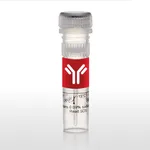Thermo Fisher Scientific Phospho-c-Abl (Tyr226) Polyclonal Antibody
다른 상품 둘러보기
Applications
Tested Dilution
Publications
Western Blot (WB)
1:500-1:2,000
Immunohistochemistry (Paraffin) (IHC (P))
1:50-1:200
Immunocytochemistry (ICC/IF)
1:100-1:500
Product Specifications
Species Reactivity
Human, Mouse, Non-human primate, Rat
Host/Isotype
Rabbit / IgG
Class
Polyclonal
Type
Antibody
Immunogen
A synthesized peptide derived from human ABL1(Accession P00519), corresponding to amino acid residues around phosphorylated Tyr226. if (typeof window.$mangular === undefined || !window.$mangular) { window.$mangular = {}; } $mangular.antigenJson = \[{targetFamily:c-Abl,uniProtId:P00519-1,ncbiNodeId:9606,antigenRange:226,antigenLength:1130,antigenImageFileName:PA5-114555_c-Abl_P00519-1_Rabbit.svg,antigenImageFileNamePDP:PA5-114555_c-Abl_P00519-1_Rabbit_PDP.jpeg,sortOrder:1}\]; $mangular.isB2BCMGT = false; $mangular.isEpitopesModalImageMultiSizeEnabled = true;
View immunogen .st0{fill:#FFFFFF;} .st1{fill:#1E8AE7;}
Conjugate
Unconjugated Unconjugated Unconjugated
Form
Liquid
Concentration
1 mg/mL
Purification
sequential chromatography
Storage buffer
PBS with 50% glycerol
Contains
0.02% sodium azide
Storage conditions
-20°C
Shipping conditions
Wet ice
RRID
AB_2899191
Product Specific Information
Antibody detects endogenous levels of c Abl only when phosphorylated at Tyr226, which site historically referenced as Tyr245.
Target Information
The ABL1 proto-oncogene encodes a cytoplasmic and nuclear protein tyrosine kinase that has been implicated in processes of cell differentiation, cell division, cell adhesion, and stress response. Activity of c-Abl protein is negatively regulated by its SH3 domain, and deletion of the SH3 domain turns c-Abl into an oncogene. The DNA-binding activity of the ubiquitously expressed ABL1 tyrosine kinase is regulated by CDC2-mediated phosphorylation, suggesting a cell cycle function for c-Abl. In chronic myelogenous leukemia and a subset of acute lymphoblastic leukemias, the c-Abl proto oncogene undergoes a (9;22) chromosomal translocation producing a novel rearranged chromosome (the Philadelphia chromosome). As the result of the fusion of c-Abl sequences from chromosome 9 to the Bcr gene on chromosome 22. The c-Abl oncogene was initially identified as the viral transforming gene of Abelson murine leukemia virus (A-MuLV). c-ABL potentially regulates DNA repair by activating the proapoptotic pathway when the DNA damage is too severe to be repaired.
For Research Use Only. Not for use in diagnostic procedures. Not for resale without express authorization.
배송/결제/교환/반품 안내
배송 정보
| 기본 배송비 |
| 교환/반품 배송비 |
|
|---|---|---|---|
| 착불 배송비 |
| ||
| 교환/반품 배송비 |
| ||
결제 및 환불 안내
| 결제수단 |
|
|---|---|
| 취소 |
|
| 반품 |
|
| 환급 |
|
교환 및 반품 접수
| 교환 및 반품 접수 기한 |
|
|---|---|
| 교환 및 반품 접수가 가능한 경우 |
|
| 교환 및 반품 접수가 불가능한 경우 |
|
교환 및 반품 신청
| 교환 절차 |
|
|---|---|
| 반품 절차 |
|

